#mica ceramics
Photo

Kids Room - Teen
Kids' room - mid-sized eclectic girl kids' room idea with beige walls
#side table#wood floor#ceramic deer bust#magnetic paint · mica wallpaper#dark wood bed frame#white wood window trim
0 notes
Text
Mica Capacitors, Super Caps, Ceramic Capacitors, Niobium Oxide Capacitors
A large selection of capacitors from several manufacturers when looking for an aluminum electrolytic, organic polymer, ceramic disk, multilayer or single layer capacitor. One can also find a film, mica, tantalum, niobium oxide or supercapacitor.
1 note
·
View note
Text

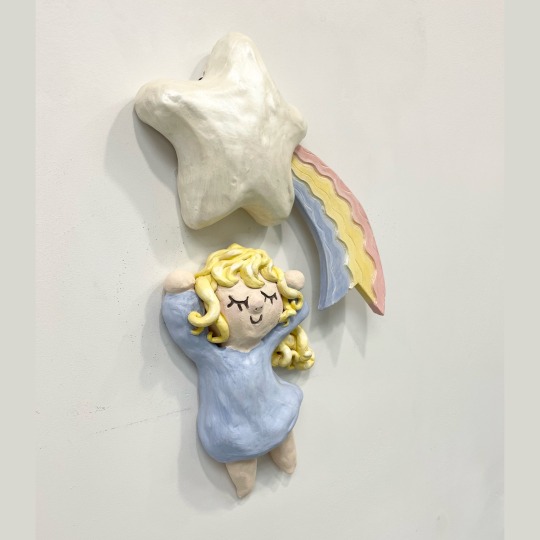

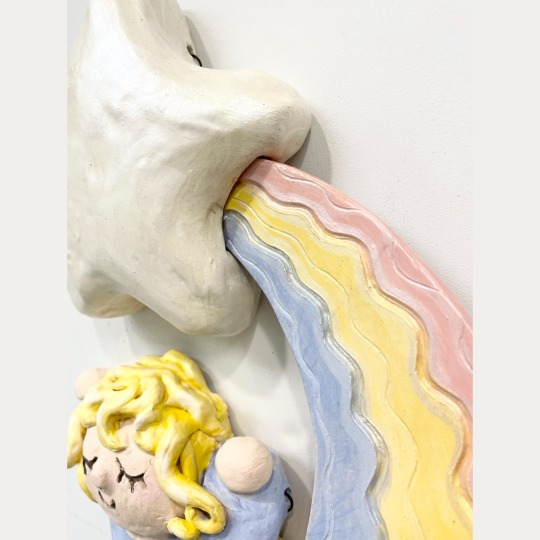
“Wishing for More, for Better”, B-mix, 12in x 8in x 4in, 2022.
First work I completed by myself this summer!!
1 note
·
View note
Text
https://www.futureelectronics.com/c/passives/capacitors/products
A large selection of capacitors from several manufacturers when looking for an aluminum electrolytic, organic polymer, ceramic disk, multilayer or single layer capacitor. One can also find a film, mica, tantalum, niobium oxide or supercapacitor.
#Aluminum Electrolytic Capacitors#NACE470M50V6.3X8TR13F#NIC Components#Samsung Electro-Mechanics#CL05B104KO5NNND#Multilayer Ceramic Capacitors#Capacitors#RF Capacitors#Aluminum Polymer Capacitors#Mica Capacitors#Super Caps#Ceramic Capacitors#Niobium Oxide Capacitors#Tantalum Capacitors
1 note
·
View note
Text
Oela Klondottir Jouea Maris sat on a bench just outside of the Western Gate of Ajax Elevator, where it emptied out onto Phoenix City's broad decumanus, and chewed a russet brick of dense gel stamped with a brief prayer to her good health. It was the sort of thing any citizen was entitled to if they presented their ration card at a government dispensary, and she could certainly afford better - Jouea Maris was seventh-seniormost traffic director for Ajax System and her stipend, from which she regularly sent her clone generous portions, was considerable - but she had found early in life that she quite liked the taste and texture of compacted brine shrimp paste and algae, at least on warm and sunny days like this, where orange-gold sunlight gleamed on every cobblestone and mica tile. Oela finished her lunch, tossing the chitosan packaging into the refuse receptacle next to her, and turned her attention to the Western Gate, its pillars carved in a dizzying tangle of gods and auspicious beasts (winged lions, winged horses, winged sphynges, mercifully wingless fish from whose mouths issued forth ten thousand precious things to bless the world), and then to the people passing through it: student cadres and throngs of workers on their sabbaticals, itinerant monks in grey Recusant robes, miners and Citadel-dwellers who peered everywhere with their insectile arrays of sensory augments, not caring one whit if they looked like tourists. The tallest woman she had ever seen exited the gate, wearing a long white jacket with flared sleeves and, under it - Oela felt herself blush - nothing but a bright red subligaculum with the areoglyph Olympus Mons printed in eye-searingly reflective blue-violet on a bulge so large she wondered if it was perhaps padded. The woman turned around after a few long strides and looked back through the gate, where a somehow even taller woman wearing a black jacket with similarly flared sleeves over a much more modest green-brown sarong walked over to meet her. The two of them strode down the street together, admiring the city gods, until they stopped in front of a massive statue of the Azure Maiden. Of course. They were Martian, just as most of the original colonists had been who brought the Azure Maiden with them when they left for Ajax in their great arks, and though her cult had declined in popularity over the millennia, the New Year Ceremony still included an invocation of her graces, as did birth and death certificates, and Oela knew that many of her rituals were still practiced among the shepherds of the southern continent. And, as she looked westward down the street, one of those shepherds was coming now, walking a few hesitant paces at a time and glancing back and forth between his enchiridion and his surroundings. He wore a coat of red-brown wool wrapped around his waist like a lungi, and his long straight hair was pinned above his head with salt-glazed ceramic hairpins. The taller of the two women spotted him and waved an arm, and he hurried over to them both, throwing his acid-scarred arms around the one in the subligaculum (though they only came to just above her hips, and his face was buried in her belly) and then turning to the other, who scooped him up in her arms like a cat and kissed both his cheeks. Oela wondered idly how they knew each other and why they were dressed so strangely - the southerner had to be sweating beyond comfort despite having stripped his coat from his shoulders, it was well over thirty-five degrees celsius, and as for the shorter woman, it wasn't unheard of for citizens to walk around nude here at the equator but her attire seemed deliberately obscene despite being technically less revealing.
14 notes
·
View notes
Note
hello excellent dirt person. do you know anything about kaolin? i am curious if so, what the Dirt Person view on it would be
So the long and short of it is I have no view on it because kaolin is just, a thing that exists. I have no view on steel or grapes. They exist. There's a lot of commercial grade uses for rock and soil that lay people wouldn't anticipate but are entirely common within certain industries, from gravel and sand mining, to the mining of rocks and soils bearing certain clay minerals or rich in certain elements. Kaolin in particular has uses valuable to ceramics and the paper industry but I know very little about either of those.
However, I do know things about the clay mineral that is actually what's extracted from kaolinite and what an excellent opportunity to talk about phyllosilicates, aka, clays and micas!
I am, more technically speaking, an environmental soil chemist, and though I lean on the last one of those titles the least, here we're going to have to take a quick detour onto chemical bond angles and crystals. This is a very brief oversimplification but deeply relevant.
Atoms bind together in order to be more stable, but the bonds themselves are charged, and therefore repel each other. Imagine an atom as an orb with things sticking out of it:
If you have two bonds, as far apart on a circle means 360/2, so the bond angle will be 180, and they'll be on opposite ends (examples: CO2)
If you have three, 360/3 means 120, and so you get something that looks like a triangle.
If you have four, then things get fun, because the previous two have been two dimensional shapes, and what you actually get instead is a three dimensional tetrahedron with an average bond angle of ~109. And when you get into silicates, tetrahedrons are your basic building block
If you have six, then your average bond angle is 90 degrees; imagine four in a square plane and two at the 'poles'. Remember these for later!

Silicates dominate our world. If carbon forms everything living, then silicon forms everything non-living. Over 90 percent of the earth's crust is formed by silicate minerals, which are as astounding diverse and varied as big brother carbon's molecules. This diversity comes in spite of the fact that silicon is near-exclusively bound in the form of the silica tetrahedron seen above.
Where we move from bond angles to crystals is the fact that each oxygen in a silica tetrahedron has two charges, meaning oxygen can be bound to two different silicon atoms, which creates a crystal lattice structure of repeating units of silica tetrahedra. Depending on how silca tetrahedra are linked together, you get the following structures:

(Fun fact! Quartz and Zeolites are some of the most chemically and mechanically stable minerals on earth, and the Tectosilicate arrangement is the exact same crystalline pattern that makes up diamonds. Anyways!)
Focusing down on phyllosilicates, the structures that form are vast molecule thin sheets of repeated chained circles of silica, which is just one of the many ways math that may seem abstract emerges in the natural world, as what forms as a result is a tesselation. Now although silicates are dominated by silica, they are not exclusively silica tetrahedra for the simple fact that the real world conditions in which these form are messy, but secondly, the tetrahedral shape means that in a sheet crystal, silica has leftover oxygens that it could share with other ions. And so what you get in nature is that phyllosilicates are not just sheets of silica tetrahedra, but are two to three layers of repeating tetrahedra/octahedral units bound to a silica backbone.

(src paper; good resource for those who want to know more)
Now these phyllosilicates, literally "sheet-silicates", are very strong and chemically resistant molecule thin layers. But the thing about being so strongly attached to itself means that the actual attraction between layers is governed by an entirely different form of chemical bond (IMFs, which we won't get into), and ranges from no real binding to tightly bound to weakly bound.
And finally, it's time to talk about kaolinite!
Kaolinite is the clay mineral named for kaolin, the rocks/sediment that bears a lot of it. Kaolinite, pictured above, has very uniform physical properties, is very chemically stable, is quite cheap, and has abundant material use.
But, time for a shock and a swerve, I spent all this time talking about clay minerals to talk about smectite instead! You fool!
Smectitic clays differ from kaolinite substantially in ways we won't get into, but the short answer of it is that bonds form between sheet layers, but weak bonds. Strong bonds will basically not really come apart and aren't an issue. No bonds aren't an issue. Weak bonds are an issue.
What weak bonds between layers leads to is a shrinking and swelling of clay layers over time, as water enters clay layers in the fall through spring, then leaves in the summer, causing the entire soil to shrink and swell with moisture, like thermal expansion joints on bridges but much more pronounced. This also leads to a lot of interesting soil properties, so much so there's an entire soil order named for soils with smectitic clays, the Vertisols.
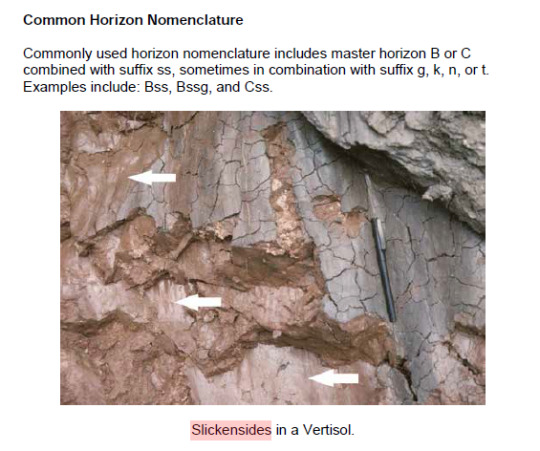
What's shown here with the slickensides are literal smooth surfaces that form as large units of soil shrink-swell and rub against each other. Very strange stuff!
On the human scale, soils with vertic characteristics cause a lot of headaches in the places I grew up, meaning a lot of people in North to Central Texas spend time watering their lawns in deep summer heat to avoid foundations cracking. I've seen new homeowners in Texas who didn't know about it have their entire fence come down because of soil cracks, especially wood fences that catch the wind.
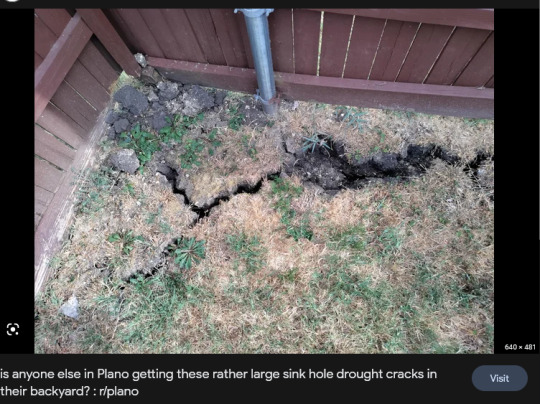
And that's how clay will ruin your foundation.
(PS: Clay mineralogy is foundational to soil chemistry but we'll get into that at a later date. To simplify: clay mineralogy is variable by geology and essentially serves as the most chemically active site in soils, but you kind of have to get real in the weeds on it and I do not have time to get into ion substitution and why every mineral's chemical formula looks like a fucking math equation just so I can talk about cation exchange capacity right now.)
15 notes
·
View notes
Text
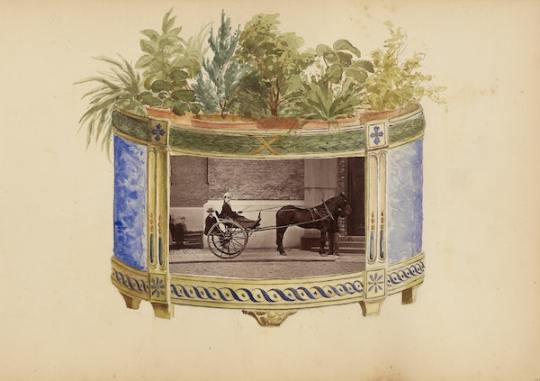
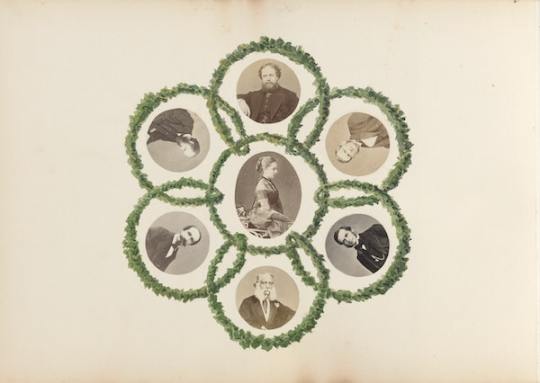
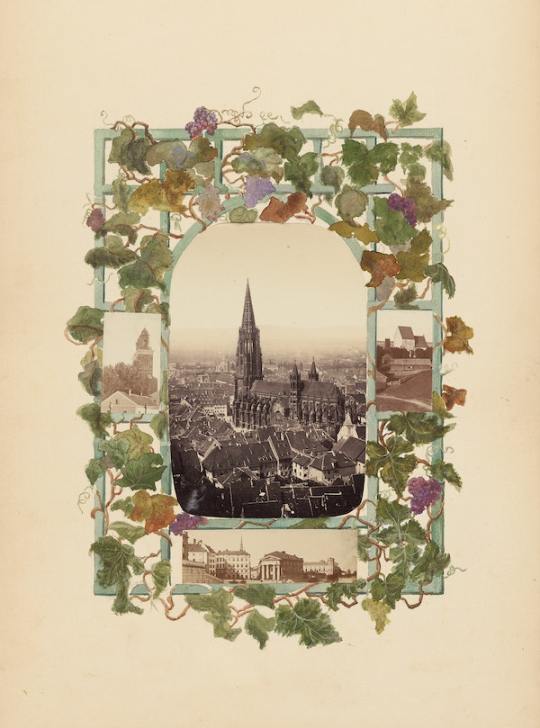

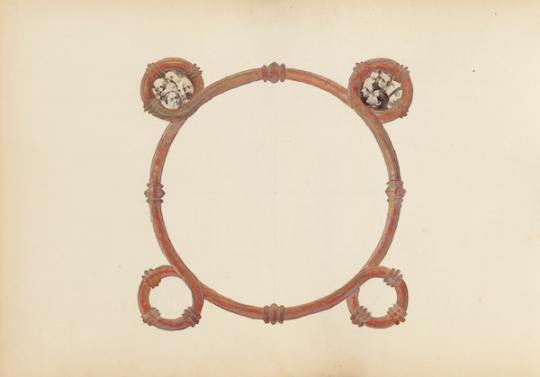
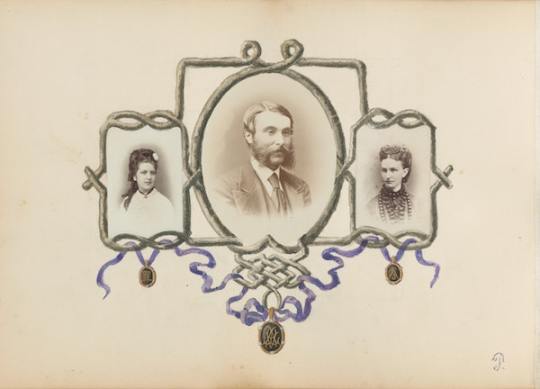

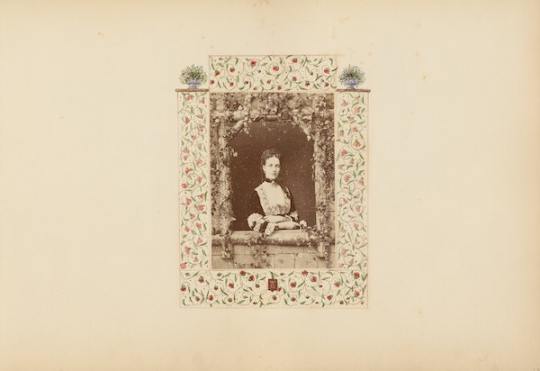
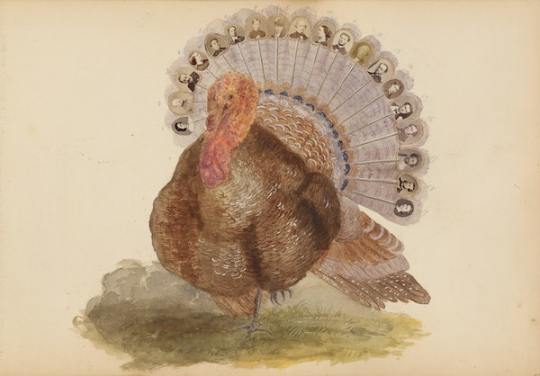
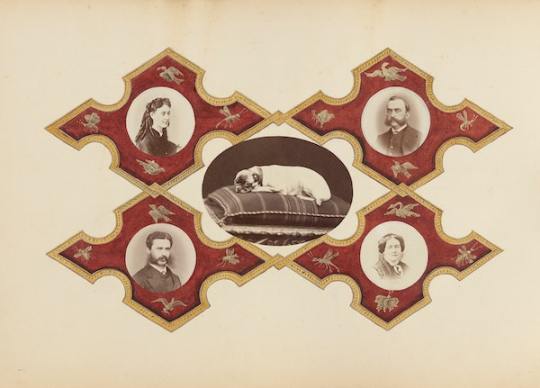
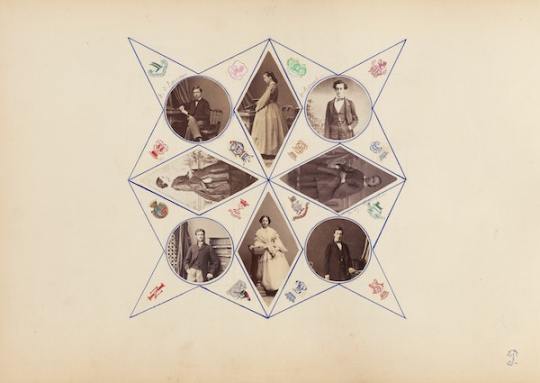
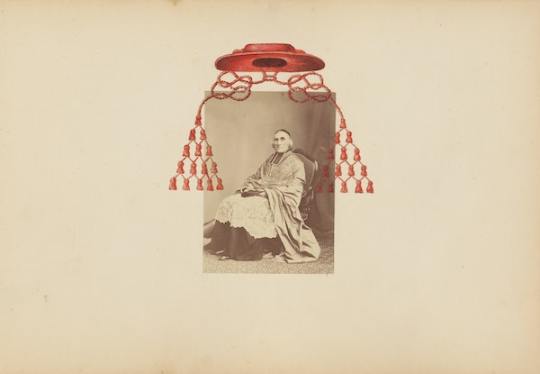


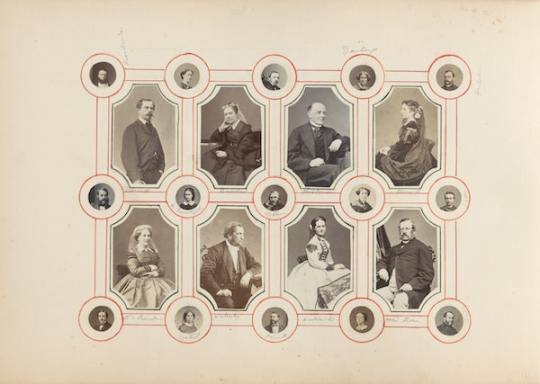


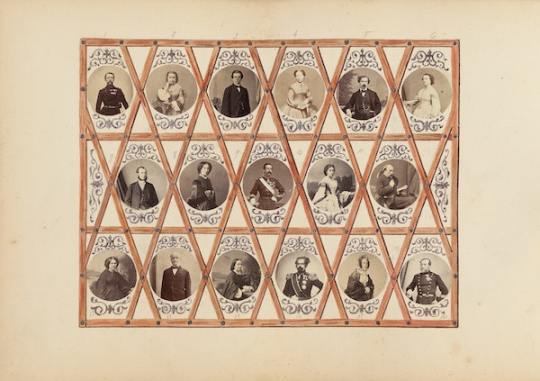
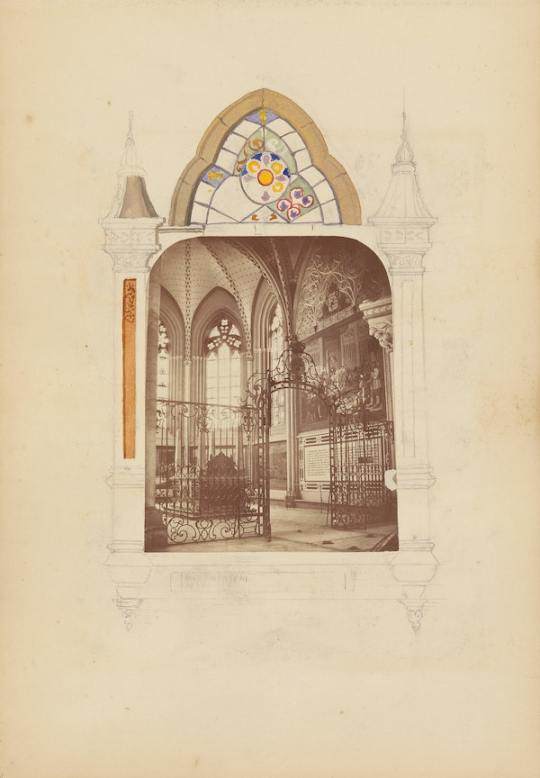


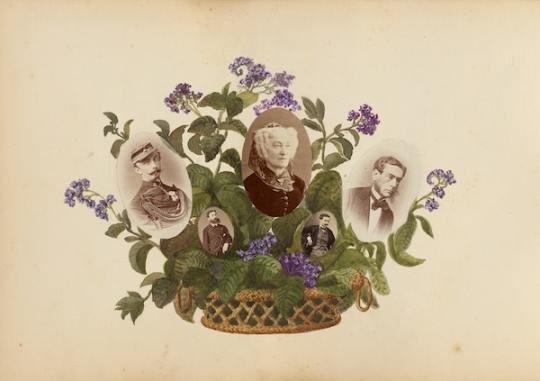
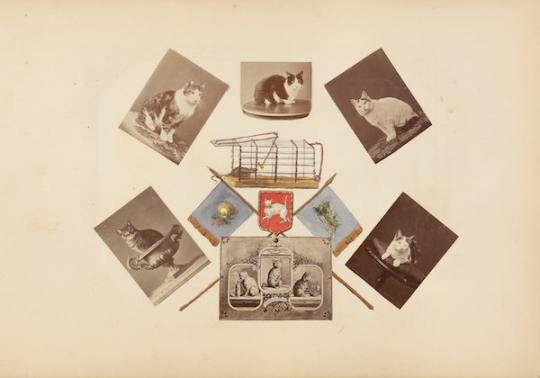

"The 'Madame B Album' wasn't intended for public exhibition, even though the artist paid little attention to its presentation. This leather-bound volume comprises hundreds of collages, offering a Victorian delight in imagery where photographs take on various forms and arrangements. Known as Madame B, the artist specialized in creating intricate, fantastical watercolor decorations for photographic portraits of friends, family, and even pets. She placed photographs in whimsical settings, such as turkey feather tails, the loops of a blue endless chain, bouquets, and pitchers. Men in suits form the wings of butterflies, while women with muffs balance on snow-covered trees. Photographs dangle from a bird's beak and a horse's harness, with seven individuals ensnared in a spider's web.
Madame B's meticulousness is almost manic, and her touches are as precise as one would expect from a miniature artist. On an exceptionally delicate collage, thousands of faint lines evoke a frenzy, a delicate membrane reminiscent of poorly fused ceramics. On the other hand, uneven strips of pink suggest marble. Photographs are outlined with ribbons, sticks, pine branches, and wrought iron, mica terrazzo, and rush. The depiction of a majestic building is draped with chainmail curtains, each link a meticulous representation. Like many artworks and crafts created by Victorian women, the album is unsigned; the Art Institute of Chicago acquired it with no knowledge of the creator, giving it the enigmatic title because the first page features an elaborate doorway monogrammed with 'B.'
Close examination and curatorial investigation revealed that the artist was familiar with the French language and spent time in Sweden and later in Italy. She was a skilled watercolorist and draftsman, indicating a likely aristocratic education. Various social circles, represented in the calling cards within the book, were carefully chosen: who might have a photograph of the Swedish king, the Italian queen, or a Russian family named Polovtsov? By a well-founded assumption, the name eventually attributed to the 'Madame B Album' was Marie-Blanche Hennel Furne, known as 'Blanche,' married to the professional diplomat Hughes-Marie Henri Furne. Blanche had a daughter named Pauline. Whether she genuinely loved her husband or at least hinted at it through the symbolism of flowers adorning his photograph is uncertain. She lost interest in her album, leaving many collages unfinished."
#art#digital art#books & libraries#music#vintage#books#artists on tumblr#illustration#collage#symbols#antique
3 notes
·
View notes
Note
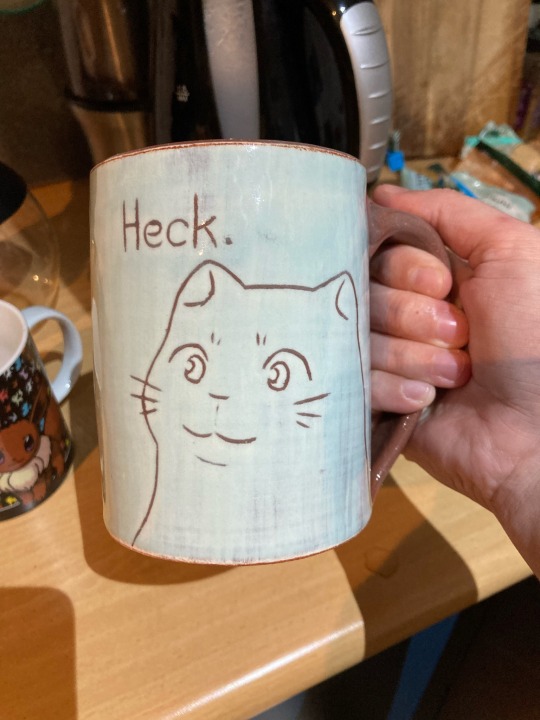
Hello sorry DID YOU MAKE THIS MUG I BOUGHT IN VANCOUVER 4 YEARS AGO I just saw your heck cat ceramic videos and was like wait I think one of those guys is in my cupboard
HELLO YES I did definitely make that mug!
That's a early iteration of my current heck mug design:
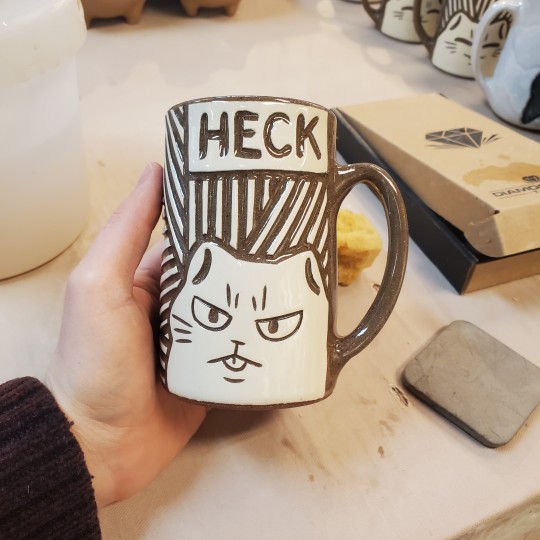
(I grabbed this image before I realized it's the one I forgot whiskers on lol whoops)
Fun fact the clay body your mug is made of has mica in it, which makes it not only a very strong low fire clay but it also gives it the sparkles! I love and miss that clay, as I moved to mid fire clays.
#thank you for sharing this!#i love seeing the old designs#i forget i made them and then oh gosh they exist in the world!
76 notes
·
View notes
Text
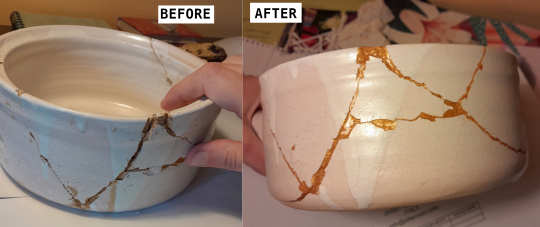
My first attempt at fake* kintsugi! Thank you @nayvi for advice + golden mica powder!! Detailed process + reel under the cut.
*fake 'cause it's not actual gold, it's epoxy with gold pigment

The vase was made by Edith Merle in 1985 and I inherited it already broken and glued together with superglue. She is a sculptor known primarily for her ceramic "birds", and happened to be a friend of the family, so we have quite a few of her lovely birds, this one, Jonas II, being the largest.


I used acetone to unglue it and to carefully (with q-tips) remove all glue residue. Then I mixed some 2-component epoxy resin with golden mica powder and used that to carefully stick the pieces together. That took 3 sessions (attach 1 piece, wait for it to cure until tomorrow, etc)


Of course, I worked with gloves and the window open, while handling epoxy. At all times I had warm water + q-tips that I used to remove excess epoxy while it was still soft. I wasn't able to attach the pieces very precisely, and I had to sandpaper the last one quite a lot to fit it.
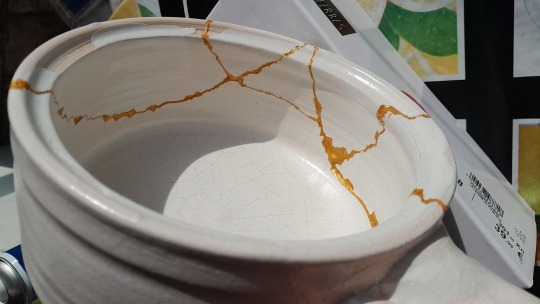
Then I had 2 sessions of filling in the bigger gaps and editing smaller details with a fine brush. The final session was to sandpaper away small mistakes and stains of epoxy. I didn't remove 100% of the stray droplets and drips, because I liked some of them.


Finished, with its lid! Unfortunately, the lid doesn't fit very well after these repairs :/ But alas. Still better than it was with superglue, and not bad for a first attempt. Then again, as sparkly as the golden epoxy is, it cannot measure with the texture and shine of real kintsugi. I wonder how difficult it would be to do it the traditional way, hmmmmm.... Anyway, to finish here is an accursed reel I made for IG
5 notes
·
View notes
Text
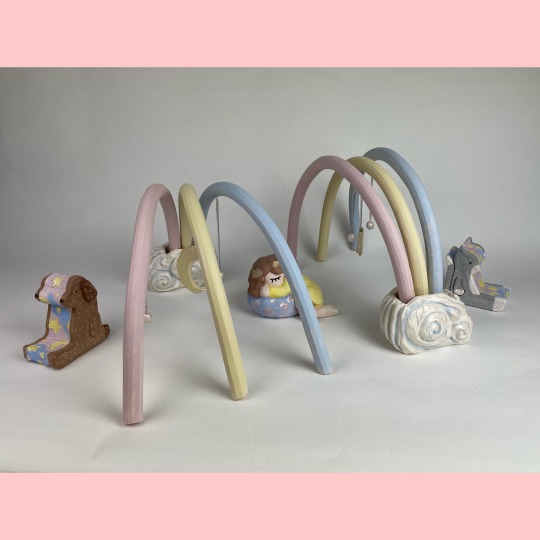
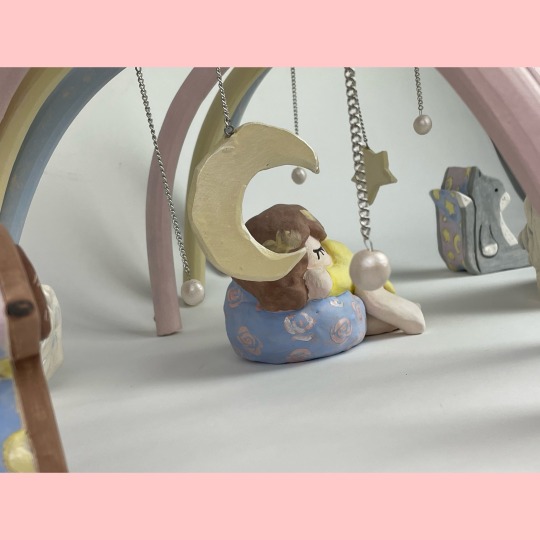
The Kids a Day Dreamer, Stoneware, 18in x 24in x 10in, 2022.
Check out my Instagram @/hun_bun_bee for more detail pics^^
1 note
·
View note
Text
Am currently considering the next round of Experiments with Stede Bonnet's historically accurate 1711 lip balm.
Next round, I think, I'm going to attempt:
adding more orange-flower water (because "spoonful" feels less like a measurement and more like a Mood)
leaving out the arrowroot and colored mica entirely
slightly different labeling
avoiding if at all possible exploding the kitchen (again)
IF I can do so within the next week, I might also try a THIRD variant where I switch out the coconut oil (which was already a replacement for the "fresh butter") for sweet almond oil (which is the 1709 French edition's oil/fat of choice) -- or I might actually try the butter, because woooooo none of this has preservatives in it anyway, might as well go full-on Science with this and just warn for uncertain spoilage rates.
(THING I HAVE RECENTLY LEARNED: The USA's FDA is extremely lenient when it comes to regulations surrounding cosmetics, to the point of not requiring any sort of safety test before going on the market. To be honest, unless I add in a modern broad-spectrum preservative to prevent mold, bacteria, rancidity, etc., all of these historical recipes are going to be subject to various short shelf-lives and require warning labels-- and if they go outside the US, they gotta stop being 'lip balm' and start being "for educational and entertainment purposes only" or something.)
(Because it is EDUCATIONAL to learn what Stede could have been wearing and its relative shelf life under historical conditions, and it is ENTERTAINING to consider Ed staring at Stede as he dabs this spice-cookie scent on his lips of all places, touching it up throughout the day as he wanders the deck, carefully reapplying it after evening drinks each night, leaving an almost-finished little ceramic jar of it out amongst his other beautiful salves and unguents so that it's really very easy for Ed to just palm it and lie when Stede wonders where it wandered off to, small enough to tuck away until he's back in his own berth and prying up the delicate hinged lid and reaching one hemp-rough finger in to swipe up the barest blush of softened wax and raise it up to smell it first, brief inhale that's Stede, his clothes and his rooms and his hair and Ed slowly touches his own lips with Stede's scented softness and stays like that, curled forward over the bright little jar and its devastating little effect until the lamp begins to gutter and ship's bell rings the morning watch)
#orange you glad to see me#our flag means death#history#research#fandom shenanigans#experimental archaeology#science!#free plot bunnies#if you write it link it#do the thing#stede bonnet#edward teach#ed teach#stede bonnet's lip balm#trifles the amateur history enthusiast strikes again#funky little alchemist with funky little interests
28 notes
·
View notes
Text
tagged by @khrushchov and @mybloodiedvalentine to post some songs i have been listening to lately. thank you so much! some of these are purely out of nostalgia
footsteps in the fog by ceramic hello
piano II by vanessa amara
fade by NONE
forest of disintegration by tollund men
wings by mica levi
more days by vår
kiss of death by inextremis
soft city by bourbonese qualk
like spinning plates by radiohead
moya by gsy!be
tagging @not-sure @undinesea @comelay @darkartzero @madc0w and @ermor if you would like to do this!
14 notes
·
View notes